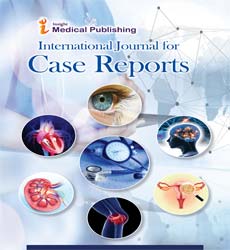Kidney Injury and COVID-19
Jason Blanc*
1Department of Microbiology and Immunology, Dalhousie University, Nova Scotia, Canada
- *Corresponding Author:
- Jason Blanc Department of Microbiology and Immunology, Dalhousie University, Nova Scotia, Canada E-mail: joson.leblanc@nshealth.ca
Received Date: June 7, 2021; Accepted Date: June 21, 2021; Published Date: June 28, 2021
Citation: Blanc J (2021) Kidney Injury and COVID-19. Int J Case Rep Vol.5 No.4:e049
Abstract
Extracellular Vesicles (EVs) are lipid bilayer particles released by different cells that provide a non-invasive real-time snapshot of the condition of these cells in tissue. EVs contain mRNA,
miRNAs, proteins, and metabolites, among other things. As a
result, EVs have the potential to be used to develop liquid
biopsy-based biomarkers for illness diagnosis. The current study
used liquid chromatography/mass spectrometry to analyse the
metabolome of urine EVs in rats with kidney injury caused by
cisplatin and puromycin aminonucleoside to find possible
biomarkers that represent the kind and amount of harm in druginduced
nephrotoxicit.
Description
Extracellular Vesicles (EVs) are lipid bilayer particles released by different cells that provide a non-invasive real-time snapshot of the condition of these cells in tissue. EVs contain mRNA, miRNAs, proteins, and metabolites, among other things. As a result, EVs have the potential to be used to develop liquid biopsy-based biomarkers for illness diagnosis. The current study used liquid chromatography/mass spectrometry to analyse the metabolome of urine EVs in rats with kidney injury caused by cisplatin and puromycin aminonucleoside to find possible biomarkers that represent the kind and amount of harm in druginduced nephrotoxicit. These chemicals may indicate changes occurring within injured cells during kidney injury, according to pathway analysis, suggesting that metabolomics of urine EVs could be a useful instructive technique. Cisplatin-induced acute kidney damage (AKI) is linked to a high rate of morbidity and mortality around the world; however the underlying mechanisms are unknown. Downstream-of-kinase 3 (Dok3), a member of the Dok family of adaptor proteins, is involved in inflammatory response and immunological control, although its role in cisplatin-induced AKI is unknown. Staining using Hoechst. ELISA kits were used to evaluate inflammatory factors. Western blot analysis and real-time PCR were used to determine protein and gene expression levels, respectively. Dok3 was shown to be expressed in renal tubular epithelial cells, according to the findings. In the kidneys of cisplatin-treated mice and cisplatintreated HK2 cells, Dok3 expression was reduced. The link between cellular senescence and kidney fibrosis is being investigated, and recent investigations have highlighted it as a potential therapeutic target. Chronic kidney disease has evolved into a lifestyle illness, frequently occurring alongside hypertension and dyslipidemia. In DKO, there was more DNA damage and the creation of TASCCs (target of rapamycin– autophagy spatial coupling compartments). Even after injury, animals with endothelial dysfunction and dyslipidemia developed renal fibrosis and hastened senescence. These findings emphasise the importance of controlling lifestylerelated disorders from a young age in preventing CKD. Acute kidney damage (AKI) is a potentially fatal rhabdomyolysis consequence. The pathophysiological processes of rhabdomyolysis-induced AKI (RIAKI) have been extensively explored in the murine system, but clinical translation to humans has been sparse. The cellular and molecular processes of human RIAKI were examined in this work. Quantitative immunohistochemistry (Q-IHC) was used to investigate renal biopsy tissue from an RIAKI patient and compare it to healthy kidney cortical tissue. Myoglobin casts and uric acid were found around histological tubular damage sites, confirming the diagnosis of RIAKI. Inflammasome activation foci were found in close proximity to these immune cell infiltrates, with significantly higher staining for adaptor protein ASC (Apoptosisassociated speck-like protein containing a caspase activation and recruitment domain) and active caspase-1 in the RIAKI tissue than in the healthy control. Our clinical findings uncover many pathophysiological pathways previously only documented in murine RIAKI, giving the first evidence in humans relating tubular oxidative stress/necroptosis, inflammasome activation, and necroinflammation to deposition of myoglobin and presence of uric acid. Kidney damage and chronic kidney disease have been clearly characterised and categorised, resulting in more effective research and management techniques and recommendations.
Open Access Journals
- Aquaculture & Veterinary Science
- Chemistry & Chemical Sciences
- Clinical Sciences
- Engineering
- General Science
- Genetics & Molecular Biology
- Health Care & Nursing
- Immunology & Microbiology
- Materials Science
- Mathematics & Physics
- Medical Sciences
- Neurology & Psychiatry
- Oncology & Cancer Science
- Pharmaceutical Sciences
